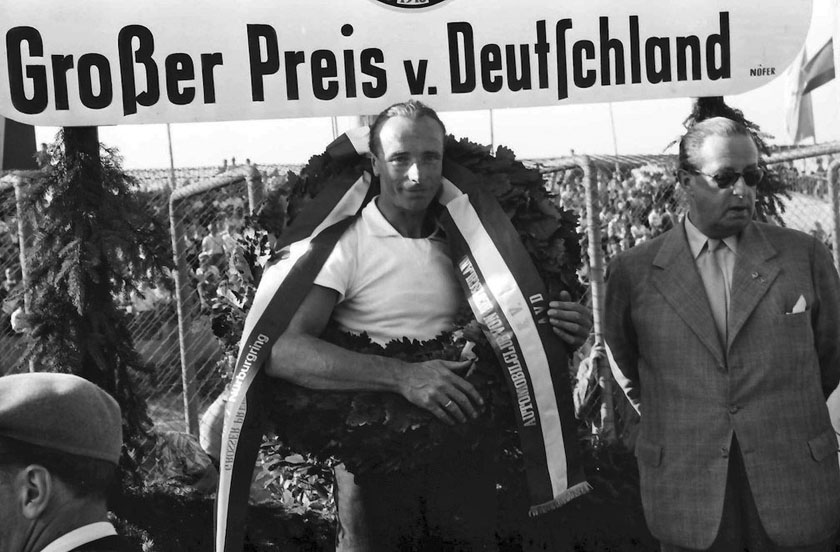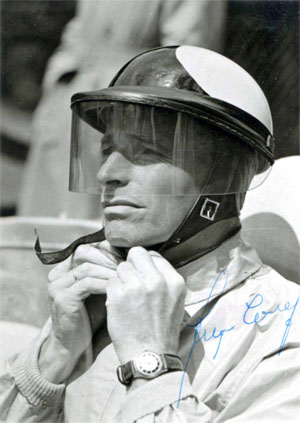Wilfried Edgar Barth (26 January 1917 in Herold – 20 May 1965 in Ludwigsburg) was a German (East German until 1957, then West German) Formula One and sports car racing driver. Info from Wiki
Bio by Stephen Latham
Born in the village of Herold, near Chemnitz, in 1917, Edgar Barth’s racing started with bikes in 1933, at the age of just 16. After first contesting trial events he then entered road races as well and in 1937 he was signed up as a factory rider by DKW. Following this he began car racing with a BMW until the War but afterwards his home was now classed in the eastern zone of Germany, which was under Russian control.
He began racing a Norton in East Germany and in 1951 was hired by its official racing team (Johannisthal Racing Collective), which was based in workshops at an airfield in Berlin. They used cars which had been built by EMW (Eisenacher Motorenwerk) who had taken over BMW’s old factory. After being taken over, the factory had continued producing cars and motorcycles under the BMW brand but after a lawsuit in 1952 they had to change the name to EMW. The logotype was also similar but instead of the blue colour used by BMW, EMW used red.
His performances led to him becoming EMW’s leading driver and the company was occasionally allowed to send cars to the West so he made a Grand Prix debut in an EMW at 1953’s German GP. He retired on lap 12 due to exhaust problems though finished fourth in a race at Avus.
1954 saw victories at Halle and podiums at Sachsenring and Bernau plus a fourth place finish in the GP Berlin. There were victories the following year at Dessau, Halle, Sachsenring and Leipzig plus podiums at Leipzig and the 500km Nurburgring. Continuing with the EMW in 1956 he won the GP de Paris then raced an AWE to victories at Leipzig and Dessau plus a podium at Solitude. Political issues had caused his appearances in the West to be limited but after being allowed to race the EMW in 1956 at Montlhery (France), he made such an impression that Porsche offered him a factory drive. However, the East German authorities were against it but he took the matter into his own hands and having gained permission to race a motorbike at Hockenheim, he also raced a Porsche in the Nurburgring 1000km (with Umberto Maglioli). The East German authorities were furious and banned him for life from taking part in any motorsport event within the GDR. Realising that if he returned to East Germany he would never again be allowed to travel to the West, he defected, forfeiting his possessions in the East and moved to Kornwestheim, near Porsche’s factory in Stuttgart.
In 1957, July saw a GT1.6 class victory in the Reims 12 Hours in a Porsche 356 Carrera with Richard von Frankenberg while in November he and Huschke von Hanstein raced a 718 RSK in the Venezuela Grand Prix, taking a victory in S2.0 class.
The year saw him in a Formula 2 Porsche in the German GP, finishing twelfth, and he returned the following year to take sixth in a similar F2 car. Also in 1958 he was third in the 718 at Zeltweg, the Nurburgring and the GP Berlin while in shared drives his best results were fourth with J.Behra in the Tourist Trophy and fifth with a Porsche 550 in the 1000km Buenos Aires (with R.Mieres and Von Dory).
He would make another appearance in the Formula 1 World Championship in 1960 and finished seventh in the Italian GP at Monza with a Porsche 718. During this period there were further F2 races and there was also a sensational overall victory in a Porsche 718 RSK in 1959’s Targa Florio with Wolfgang Seidel. 1959 would see a fifth place finish in the Sebring 12 Hours with John Fitch.
However, it was in hillclimbs that he enjoyed his greatest success, winning the European Hillclimb Championship in 1959, 1963 and 1964.
In 1959’s championship he took three victories from three starts wth a Porsche RSK on his way to the title. In 1963 he was unbeatable in a 718 WRS and at the first event in Rossfeld, the constantly changing weather conditions affected all the drivers but he drove well and beat the favourites. Following this he went on to win at Trento Bondone (Italy), Cesana-Sestriere (Italy), Freiburg-Schauinsland (Germany) and Gaisberg (Austria) though at the last race of the season in Switzerland, his fuel pump failed. However, he had already scored enough points to become the Champion again, in a second year in a row, ahead of Heini Walter and Hans Herrmann. In 1964, he won with an Elva Porsche at Rossfeld but contested the other races with the 718 RSK and won at Trento Bondone, Cesana-Sestriere and Freiburg, taking the title for the third time, ahead of Herbert Müller, who was also racing for Porsche.
He also competed at Le Mans on several occasions, racing a Porsche each year from 1957 to 1964 (alongside U.Magliloli in 1957, P.Frere in 1958, W.Seidel in 1959-1960, H.Hermann in 1961-1962 and H.Linge in 1963-1964). His best result came in 1958, finishing fourth with Paul Frere to win the 1500cc class. In 1963’s race, the Porsche 718 W-RS lost a rear wheel though Edgar pushed the car half a kilometre back to the pits holding the rear corner up. The car was repaired and continued the race and they came home eighth.
During this period, other strong results included fourth in the 1960 Trophée d’Auvergne with a 356B Carrera then third in 1961’s Targa Florio (with H.Hermann) and second in the 4Hr Pescara with Orthuber. Into 1963 he and H.Linge were third in the Targa Florio and following this came a fourth in the 1000km Nurburgring, alongside H.Walter, B.Pon and H.Ling.)
In early 1964 he raced a 356 Carrera at Daytona with J.Bonnier and H.Linge and in the March a Porsche 718 RS Spyder was shipped to America to contest the Sebring 12 hour race but, competing against the dominant Ferraris and Shelby Cobras with much larger engines, he and Herbert Linge finished twentieth. Back in Europe, he co-drove a 904/8 at the Targa Florio with Umberto Maglioli and they finished sixth and first in P2 class. Following this took fifth in a 904 in the 500km Spa and had a podium finish with Colin Davis in the 1000km Paris race.
He made a final F1 appearance driving Rob Walker’s Cooper T66-Climax in the 1964 German GP though retired from it due to clutch problems. Sadly, by now Edgar had been diagnosed with cancer and he passed away nine months later in hospital in Ludwigsburg, aged only 48.
His son Jurgen later became a Porsche factory sports car driver and won Le Mans with Jacky Ickx and Hurley Haywood in 1977.

Gallery Other





